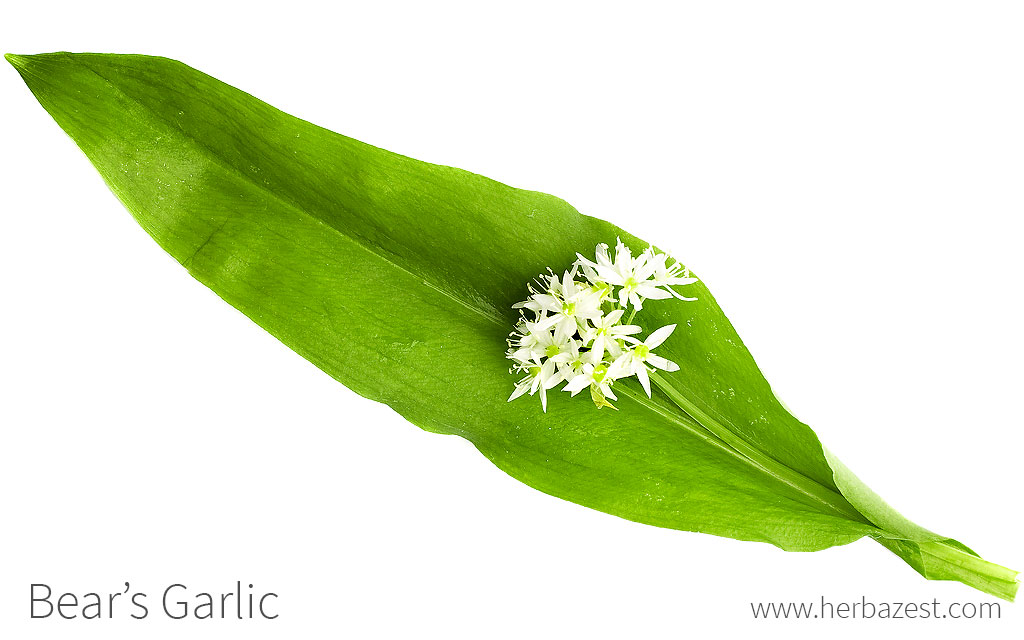Revered for its blood-cleansing properties, bear's garlic, also known as ramson garlic and wild garlic, among other names, is one of the oldest and most popular medicinal plants among animals and humans alike. Read on to learn more about bear's garlic and its present-day uses below.
Bear's Garlic Medicinal Properties
Health Benefits of Bear's Garlic
Considered medicinally more potent that common garlic, this underrated herb is packed with antioxidant, cardioprotective, antimicrobial and antifungal healing properties. The most popular and studied bear's garlic health benefits are:
Improving cardiovascular health. The antiplatelet activity in bear's garlic is responsible for thinning out the blood and reversing hypertension. On the other hand, bear's garlic has been shown to lower harmful cholesterol levels, thus preventing cardiovascular disease.
Fighting infectious diseases. Thanks to its potent antimicrobial action, bear's garlic helps to fight off bodily infection caused by bacteria, virus, and fungi. It can be used to speed recovery from the common cold.
In addition to these main benefits, research indicates that regular treatment with bear's garlic can help eliminate toxins from the body and ease gastrointestinal problems.
Bear Garlic is a heart-healthy herb, known to improve circulation and reduce the risk of developing cardiac arrhythmia.
How It Works
Although it is composed of a long list of natural substances, bear's garlic health benefits are thought to come from its high content of sulfuric compounds, phenols, and steroidal glycosides, all of which are believed to be responsible for the strong antimicrobial and antifungal actions of the herb.
Bear's garlic health benefits are comparable to common garlic in many regards, but its chemical mechanisms are still being investigated. Some studies have shown that the herb is nearly 20 times higher in adenosine (a type of glycoside), and offers twice the normal content of ajoene (a sulfur-containing compound) when compared with other Alllium species. Both compounds seem to work together to stabilize blood pressure and cholesterol levels, reduce excessive coagulation and improve cholesterol metabolism.
Bear's garlic active compounds are thought to interact with calcium and potassium channels to promote blood vessels' dilation and inhibit coagulation.
Other herbs with cardioprotective properties are avocado, olive, and sacha inchi, whereas echinacea, lime, and onion are also effective to treat and ward off the common cold, as well as other infectious diseases.
Bear's Garlic Side Effects
With no serious side effects, bear's garlic is mostly safe when consumed as a food crop. In special cases, however, it may cause allergic reactions in sensitive individuals.
Bear's Garlic Cautions
People sensitive to Allium species, such as garlic, onion, leek, and shallot, should avoid taking bear's garlic. Breastfeeding women, children, and expectant mothers are likewise discouraged from its use due to a lack of clinical testing across these demographics.
Bear's garlic is a blood-thinning herb that increases the likelihood of bleeding when taken with warfarin or other anticoagulant drugs.
- Medicinal action Antimicrobial, Cardioprotective
- Key constituents Sulfuric compounds (mainly ajoene), steroidal glycosides (mainly adenosine), phenols
- Ways to use Capsules, Decoctions, Tincture
- Medicinal rating (2) Minorly useful plant
- Safety ranking Use with caution

How to Consume Bear's Garlic
Containing the highest known levels of ajoene and adenosine in the plant kingdom, bear's garlic, or wild garlic, is most commonly substituted for regular garlic in cooking. The leaves of this herb are also edible, and they can be used to add flavor to pizzas, salads, pasta, and pesto sauces.
The best way of reaping all bear's garlic health benefits is to consume the herb in medicinal forms, such as capsules or liquid extracts.
Every part of bear's garlic holds medicinal value.
Natural Forms
Cooked. The bold, onion-like taste of fresh bear's garlic bulbs makes them attractive as boiled vegetables in hot soups, from where the antimicrobial and cardioprotective properties of the plant can be obtained.
Decoction. Often overlooked in medicinal preparations, the stems and bulbs of bear's garlic can be boiled to obtain a concentrated liquid, which can be taken orally in order to lower blood pressure and cholesterol, as well as for fighting the common cold and other infectious diseases.
Remedies
- Tincture. Ingesting about 30 - 60 drops of bear garlic tincture twice daily can provide the body with all it needs to recover from illness.
Capsules. Capsules are stuffed with the dried leaves of the bear garlic plant to provide a consistent dosage of cholesterol-lowering herbal treatment.
- Taste Pungent

Growing
Bear's garlic, also popularly known as ramson garlic and wild garlic, is a low-maintenance herb that is best cultivated in temperate zones. The following guidelines will help to ensure that growing bear's garlic is an easy, stress-free experience for gardeners of all skill levels.
Growing Guidelines
Like its close relative, common garlic, bear's garlic thrives in cool weather, and is most commonly planted during the fall so that it can have the entire winter to start developing its root system.
While it tolerates a range of pH levels, wild garlic prefers slightly acidic soil between 6.2 and 6.8.
Bear's garlic grows best in sandy, well-drained loams, which protect the plant from waterlogging.
Bulbs are planted directly into the ground, spaced at about 6 inches (15 cm) apart in neat rows.
Bear's garlic is susceptible to several pests and diseases, including onion flies, thrips, white rot, mildew, and fungal leaf spot. Thus, good cultivation practices and quality pest control are required to help manage these problems.
Wild garlic leaves and flowers can be harvested each spring. Meanwhile, the bulbs can be dug up every summer and replanted for growth in the new season.
- Life cycle Perennial
- Harvested parts Leaves, Bulb
- Light requirements Partial shade
- Soil Loamy sand
- Soil pH 5.6 – 6.0 (Moderately acidic), 6.1 – 6.5 (Slightly acidic)
- Growing habitat Temperate climates
- USDA Plant Hardiness Zones 4a, 4b, 5a, 5b, 6a, 6b, 7a, 7b, 8a, 8b, 9a, 9b
- Plant spacing average 0.15 m (0.49 ft)
- Potential insect pests Thrips, Onion maggots
- Potential diseases Leaf spot, Mildew
Additional Information
Plant Biology
Bear's garlic can be found growing in the wild in damp forest landscapes in Europe and Asia. Reaching an average of 12 feet (3.7 m) tall, bear's garlic is characterized by an onion-like root that sprouts a long stem with two shiny leaves. From April to June, the plant bears a white flower that gives off a garlicky scent.
Classification
Allium ursinum is part of the large Amaryllidaceae family, represented by 59 genera and over 850 species all over the world. As a member of the Allium genus, bear's garlic is closely related to herbs like onion (Allium cepa), common garlic (Allium sativum) leek (Allium ampeloprasum), and chive (Allium schoenoprasum).
The botanical name of bear's garlic, Allium ursinum, is derived from the Latin ursus, meaning bear.
Subspecies of Bear's Garlic
According to the smoothness of the pedicel surface, there are two commonly-recognized subspecies of bear's garlic: Allium ursinum subsp. ursinum and Allium ursinum subsp. ucrainicum. While the former seems to be indigenous to western and central Europe, the latter is distributed in the eastern and southeastern parts of the continent.
Nowadays, bear's garlic is cultivated all over the world. However, it is very commonly mistaken for the poisonous lily of the valley (Convallaria majalis), whose leaves closely resemble wild garlic before flowering.
Historical Information
Bear's garlic boasts a very long history of use. The 1st-century Greek botanist Pedanius Dioscorides mentioned it in his five-volume herbal encyclopedia, touting its efficacy for the cleansing and detoxifying the body. During the Middle Ages, King Charlemagne of present-day France catalogued the plant in his Capitulare de Villis imperialibis, a guide that highlighted the medicinal properties of common herbs.
In 1992, bear's garlic was named Plant of the Year by the Society for the Protection and Investigation of European Flora. Although easily overshadowed by its more lucrative relatives, bear's garlic still holds the same wonderful health benefits that initially earned it the esteemed title.
Popular Beliefs
As legend would have it, bear's garlic was named for its apparent attractiveness to brown bears living in the plant's native region of northern Europe. Because it was often the first source of food available to them after winter hibernation, the delicious herb was believed to be a source of vitality and strength.
Other Uses
Gardening. Bear's garlic showy white flowers make it an excellent addition to the gardenas an ornamental.
Fodder. Sometimes, it is even made into fodder for cows to impart new flavor to milks, butters, and cheeses.
With potential applications for food and healthcare alike, bear's garlic has lots to offer. No wonder, then, that it is now widely cultivated outside of its native lands, and has become an increasingly popular garlic's substitute in many culinary preparations.
Sources
- American Society for Microbiology, Ajoene, a Sulfur-Rich Molecule from Garlic, Inhibits Genes Controlled by Quorum Sensing, 2012
- Encyclopedia of Life, Allium ursinum
- International Journal of Molecular Sciences, Anti-Atherogenic Properties of Allium ursinum Liophylisate: Impact on Lipoprotein Homeostasis and Cardiac Biomarkers in Hypercholesterolemic Rabbits, 2016
- Natural Product Communications, Chemical composition and antimicrobial activity of wild garlic Allium ursinum of Bulgarian origin, 2009
- Natural Standard Herb & Supplement Guide, p. 94
- Phytochemistry Reviews, Allium ursinum: botanical, phytochemical and pharmacological overview, 2015
- Medicinal Plants of the World, p. 39
- The Herb Book, p. 108
- Journal of Agricultural and Food Chemistry, Characterization and content of flavonol derivatives of Allium ursinum L. plant, 2012





